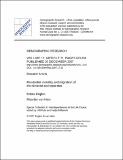Files in this item
Residential mobility and migration of the separated
Item metadata
| dc.contributor.author | Feijten, P | |
| dc.contributor.author | Van Ham, Maarten | |
| dc.date.accessioned | 2016-01-05T17:10:03Z | |
| dc.date.available | 2016-01-05T17:10:03Z | |
| dc.date.issued | 2007-12-20 | |
| dc.identifier | 438408 | |
| dc.identifier | 4a866c60-f9d8-4fb5-960b-4c7512276321 | |
| dc.identifier | 000252132000003 | |
| dc.identifier | 37549046030 | |
| dc.identifier.citation | Feijten , P & Van Ham , M 2007 , ' Residential mobility and migration of the separated ' , Demographic Research , vol. 17 , pp. 623-654 . https://doi.org/10.4054/DemRes.2007.17.21 | en |
| dc.identifier.other | ORCID: /0000-0002-2106-0702/work/64697544 | |
| dc.identifier.uri | https://hdl.handle.net/10023/7970 | |
| dc.description.abstract | Separation is known to have a disruptive effect on the housing careers of those involved, mainly because a decrease in resources causes ( temporary) downward moves on the housing ladder. Little is known about the geographies of the residential mobility behaviour of the separated. Applying a hazard analysis to retrospective life-course data for the Netherlands, we investigate three hypotheses: individuals who experienced separation move more often than do steady singles and people in intact couple relationships, they are less likely to move over long distances, and they move more often to cities than people in intact couple relationships. The results show that separation leads to an increase in mobility, to moves over short distance for men with children, and to a prevalence of the city as a destination of moves. | |
| dc.format.extent | 31 | |
| dc.format.extent | 217386 | |
| dc.language.iso | eng | |
| dc.relation.ispartof | Demographic Research | en |
| dc.subject | Family-life-cycle | en |
| dc.subject | Remarriage | en |
| dc.subject | Britain | en |
| dc.subject | Panel | en |
| dc.subject | Home | en |
| dc.subject | Age | en |
| dc.subject | H Social Sciences (General) | en |
| dc.subject | SDG 11 - Sustainable Cities and Communities | en |
| dc.subject.lcc | H1 | en |
| dc.title | Residential mobility and migration of the separated | en |
| dc.type | Journal article | en |
| dc.contributor.institution | University of St Andrews.School of Geography and Geosciences | en |
| dc.contributor.institution | University of St Andrews.Geography & Sustainable Development | en |
| dc.identifier.doi | 10.4054/DemRes.2007.17.21 | |
| dc.description.status | Peer reviewed | en |
This item appears in the following Collection(s)
Items in the St Andrews Research Repository are protected by copyright, with all rights reserved, unless otherwise indicated.

